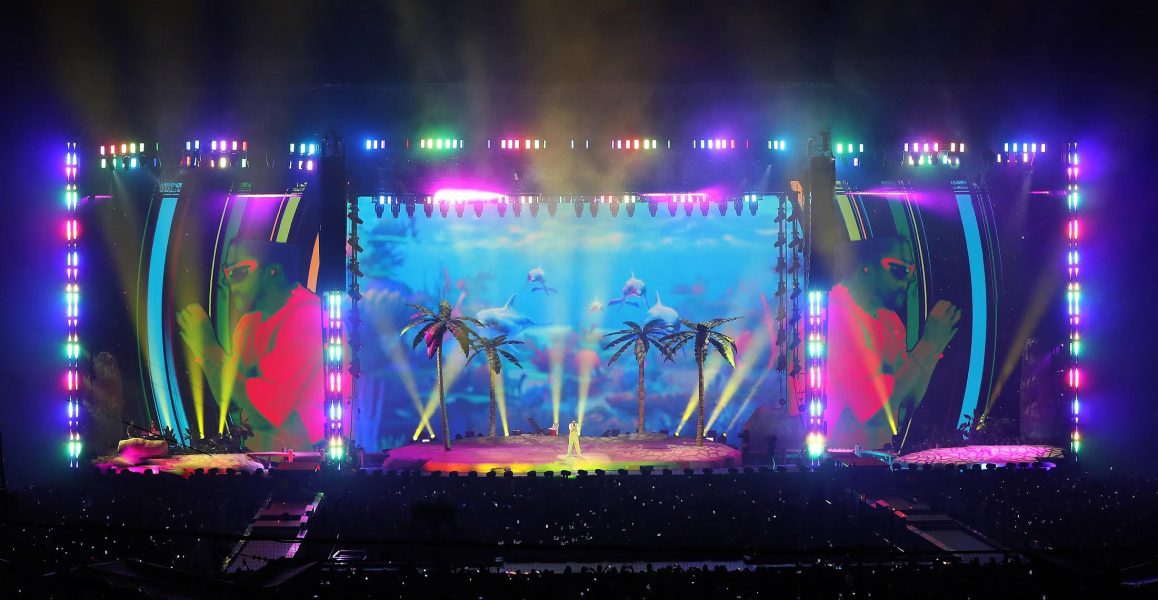Bad Bunny enjoyed a celebrated sold-out tour in early 2022 and is currently repeating the success, this time in stadiums across North and South America on his World’s Hottest Tour.
Production/Show Designer for the tour is Travis Shirley, who is using Elation Professional’s new Proteus Rayzor Blade linear light as an effect workhorse on the show. With his latest album Un Verano Sin Ti breaking records, ticket sales for the tour have been through the roof with the Puerto Rican superstar selling out across the US. A Latin American leg is set to kick off in October.
Shirley first worked with Bad Bunny last December on two triumphant shows in Puerto Rico. Following that success, he was enlisted to start design work for the World’s Hottest Tour, an ambitious trek across the Americas that launched on 5 August in Orlando. Lighting vendor for the tour is Christie Lites.
When Shirley was brought in to design for the stadium tour, a standard form of stage had already been adopted by promoter Live Nation. Although the promoter-provided stage allowed for only minimal alterations, Shirley set out to tailor it to their needs by thinking creatively and adding custom elements.
“I essentially had a black box at the end of a stadium I had to make look as custom as possible,” Shirley said, explaining that one way he did that was to push the LED screens on each side of the stage further upstage. “That opened up the stage past 180°, allowing for an extended viewing angle while essentially opening up another 5-6000 seats per show.”
That meant that the four downstage posts of the roof were literally in the middle of the stage in front of the downstage edge. “Rather than having traditional side screens hung between the roof posts right and left, we incorporated production into those posts and highlighted them with linear Proteus Rayzor Blade fixtures hung vertically,” Shirley explained. “Those four downstage roof posts became quite important to the design of the show.”
The LED-based Proteus Rayzor Blade with zoom can function as a wash, strobe or FX light and powers out up to 12,500 lumens. Two high-intensity strobe lines add extra impact and 210° tilt rotation allows them to position dynamically during a show. Shirley had seen a prototype earlier in the year and was intrigued.
“I was looking for an IP-rated linear bar that had the horsepower to compete inside a stadium and I knew it was something I’d be interested in,” he said, noting that the promoter-provided stage provided no rain protection. “I can’t tell you how many shows I’ve done that have linear outdoor lights lining runways, staging, etc. where we’ve run a risk with a non-IP fixture but now we have a solution. It’s the magnitude of what you can do with the light that is really what makes it so special. This fixture is a game changer in terms of a linear outdoor light.”
The designer wrapped lighting on three of the four sides of the roof posts. Utility lighting graced the upstage and onstage sides for side and key light onto the stage, band and dancers, while on the downstage side a vertical truss the length of the posts, approximately 70ft, was lined with the Proteus Rayzor Blades.
“Each truss had two rows of Rayzors facing out toward the crowd which really dressed up those four posts and helped to illuminate and electrify the atmosphere. The extreme amount of horsepower in a complete linear line probably hasn’t been done to this magnitude before.” Shirley uses 120m-long versions of the Proteus Rayzor Blades in the show.
Shirley says he looked on the four posts as four tall linear lights and used the Rayzor Blades for a variety of eye candy looks — ‘sizzle line’ and zipper effects for example — but also as a blinder, audience light, and strobe. Using the fixture’s tilt rotation, the designer is able to create audience sweeps and splays from right to left, “which help to open up the stage a lot.”
He also uses the fixture’s dual strobe arrays significantly throughout the show. “They are definitely one of the effective workhorses that help to keep a very dynamic show moving and electric. There are a lot of different accentuations and effects that we hit and I credit my programmer and associate lighting designer Chris Smith for figuring out a new way to give a time code look to a manually operated show.”
Shirley’s design, inspired by the beach-themed artwork on Bad Bunny’s latest album, evokes an island vibe complete with palm trees, flooring that mimics water, and bridges that connect islands. Another of the designer’s creative elements runs along the downstage edge of the stage, which has been transformed from a flat edge to the outline of Puerto Rico’s western coast. The outline is connected to the stage, giving the artist more room to move around and is a detail that the singer reportedly loves.
“I knew I needed to accentuate the custom edge of the stage, so I put a bunch of Proteus Smarty Hybrid fixtures on a custom shelf on the downstage which really helps to show off and showcase that the downstage is not a traditional flat edge but is literally the curvature of the west coast of Puerto Rico,” he remarked.
The hybrid moving heads are used mostly in beam mode to sweep the audience or are aimed straight up to showcase the unique shape of the coastline stage. On occasion, he pops in a prism and flips the fixtures backwards to light the front of the islands.
Bad Bunny’s spring tour was a huge success, selling 575,000 tickets. World’s Hottest Tour has long since passed that number with dates on the schedule running into December 2022. The US leg concluded 1 October after two shows at SoFi Stadium in Los Angeles. The Latin American leg kicks off on 21 October in the Dominican Republic.


